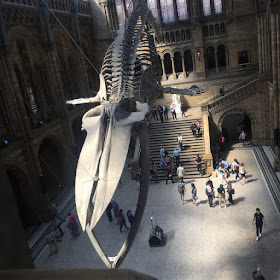Audience engagement is the easiest and hardest thing about
our work.
Let’s start with the easy. We open our doors and let people
in. We’ve done it for a couple hundred years. We understand things like door
count and fire code. We get exhibitions and installations. We’re pretty good
with time tickets. We’ve got casework and collection care sorted. Many of us
spend some quality time getting good stuff on the walls. We’re doing our best.
But our best might be the challenge. Our best is defined
within the norms of our field. Our best articles are the ones we define against
what our other scholar friends are writing. Our definitions of the best
exhibitions are either best for our field or what we think is best for
our visitors.
And, before all my research and evaluation friends have an
attack of “but wait!,” I will say that I’ve seen incredible changes in our
field in my almost twenty years in. I’d guess these changes barely register for
visitors. Why? Society is changing. T’was and always will, certainly. But the
rate of change has been FAST. And our museum change rate is glacial. The clash
is basically the thing that keeps museum leaders up at night.
How do we make the right changes to make the most of
audience engagement given our museum culture? What changes to museum culture
allow us to best grow audiences without destroying the best of our core competencies?
How do we make the choices that will keep museums from going extinct? This last
question isn’t hyperbolic. Audience engagement is part and parcel to the
survival of our work. Our future isn’t promised. We make it.
So, this month, I ask you a few questions: What are the
challenges in audience engagement? What are your successes? What are your hopes
for the future?
Before we get to the work of discussing audience engagement,
this week, let’s talk definitions. What is engagement?
I’ve been thinking recently about the words we use in our
fields. We often preference words with nebulous and complicated meanings as a
way of seeming “with the people.” Experience is one of my favorites, and not
just because it’s my job. Experience is a word you might be able to feel and
know, but it’s hard to pin down. What is not an experience? What is the
metric of a good experience?
Experience and engagement are a bit linked. A good
experience is usually engaging. Engaging is a word that overlaps welcoming,
interesting, surprising, and audience-appropriate. Engaging and experience are
absolutely in the eye of the beholder if you will. Death metal will not be
engaging to me even if performed in the loveliest place on the planet by the
loveliest people with the greatest visitor experience strategies. We all have
things that no effort will sell. So, engagement is about connecting some
people.
Engagement has grown in importance to museums because we
feel like there must be more people who could feel connected to our
organizations. On some level, that’s an assumption based on our own high
opinion of ourselves. We believe we are awesome, so people should want to come.
But one another level, it’s an admission of fault. We were doing engagement by
just opening our doors. We’re pretty sure that’s the wrong way to do it. We
know empty galleries aren’t the point of our work. And, we know we need to do
better.
But, herein lies the challenge. What does audience
engagement mean? To me, it means transformation. It means every little part of
our work. It’s about systems. Digital, parking, signage, board relations,
everything is about transforming our work.
People are at the definition of engagement to me. It’s a
word that stands in for all the efforts we make to connect people to collections.
(I talked about all the people last week).
Next week, I’ll talk about some of my audience engagement including
a couple failures. B/c failure is about learning.
In the meantime, how do you define audience engagement?
As always, tag me in your posts and shares so I can include
you in my summary post at the end of the month

